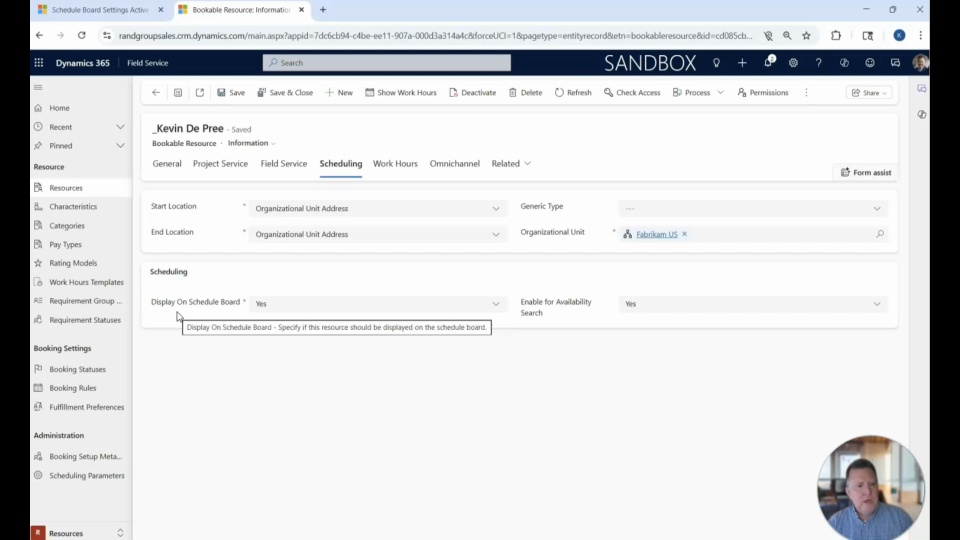Manage resources with ease in Microsoft Dynamics 365 Field Service

Managing resources effectively is critical for organizations that deliver services in the field. Companies depend on a mix of people, crews, and equipment to get the job done, but without a structured system, it’s easy to run into scheduling conflicts, underutilization, or gaps in coverage.
Microsoft Dynamics 365 Field Service provides a comprehensive approach to resource management. With its built-in tools, businesses can manage resources by defining roles and skills, setting up work hours, and monitoring utilization all in one place. These features help reduce manual effort, improve visibility, and ensure that every job has the right mix of people and tools.
In this blog, we will explore how Field Service helps organizations manage resources, how utilization and scheduling work together, and why features like crew setup and work hour templates make a real difference.
Resource types and roles
In Field Service, resources are not one-size-fits-all. The system accommodates multiple types of resources so you can accurately represent your workforce and assets:
- User resources – Employees set up in the system with assigned roles, skills, and work hours.
- Contact resources – External contractors or partners who aren’t internal users but still need to be scheduled.
- Equipment resources – Tools, vehicles, or machinery required for specific jobs.
- Crew resources – Groups of individuals and equipment that work together, led by a designated crew leader.
Each resource can be assigned roles, categories, skills, and certifications. For example, you may have a role for “Electrician,” categories for specific service types, and certifications that track compliance or licensing. These attributes ensure jobs are matched with the right resources, reducing the risk of errors or rework.
Setting up and managing crews
Crews allow organizations to group resources for jobs that require multiple people or specialized equipment. A crew can include a mix of users, contractors, and equipment.
One resource is designated as the crew leader. When the leader records time on a job, it applies to all members of the crew, including equipment. This makes time tracking more efficient and ensures the full scope of work is captured.
For example, a crew might consist of two technicians and a load bank (specialized equipment). If the leader records four hours for the job, those four hours are automatically tracked for every crew member and the equipment.
Work hours and utilization
Work hours are more than just schedules, they directly feed into utilization reporting. Utilization is the percentage of a resource’s available time that has been booked for jobs.
Here’s a simple example:
- A technician is set up with a 40-hour work week.
- If 8 hours are scheduled for work orders, their utilization is 20%.
- If 12.5 hours are scheduled, utilization rises to 31%.
This data appears on the schedule board, giving managers visibility into who is fully booked, underutilized, or overcommitted. It’s an essential tool for balancing workloads and improving operational efficiency.
Rather than setting up schedules individually for each user, Field Service allows you to create work hour templates. These templates represent common patterns such as day shift, swing shift, or night shift.
Once a template is created, it can be applied across multiple resources at once. This not only saves time but also ensures consistency across the workforce. For organizations with large teams, templates are a major efficiency booster.
Real-world application
Consider a field service company with both internal employees and contractors. By setting up roles, skills, and certifications in the system, managers can ensure that only properly qualified resources are dispatched to jobs. Crews can be created for projects requiring multiple people and equipment, with a leader assigned to simplify time entry.
On the scheduling side, work hours and utilization percentages give managers insight into resource availability. If utilization is too low, additional work can be assigned; if too high, schedules can be adjusted to prevent burnout. Over time, these tools help optimize resource use, reduce costs, and improve service delivery.

Transform the way you manage Field Service
Effective resource management is key to field operations. Dynamics 365 Field Service supports multiple resource types, crews, work hour templates, and utilization tracking to help organizations plan better and operate efficiently. Rand Group can help tailor Field Service to your operations, streamline processes, and maximize ROI.
Advantages for your business
Implementing a structured approach to resource management in Field Service can transform how your organization operates in the field. By clearly defining roles, leveraging crews and templates, and tracking utilization, businesses can streamline scheduling, improve visibility, and ensure the right resources are assigned to each job. Adopting these practices not only boosts efficiency but also supports scalability and accuracy as your operations grow.
Key benefits include:
- Improved efficiency – Reduce manual setup and scheduling with templates, crews, and leader-based time tracking.
- Better visibility – Monitor utilization percentages and availability directly from the schedule board.
- Accurate assignments – Match jobs to resources with the right roles, skills, and certifications.
- Scalability – Apply consistent resource management practices as your business grows.
Next steps
Ready to take control of your field service resources? Rand Group helps businesses implement and optimize Microsoft Dynamics 365 Field Service to fit their specific needs.
Whether you manage a small team of technicians or a large, distributed workforce, we’ll help you put the right structure in place to schedule more effectively, improve utilization, and deliver better service.
Contact us today to connect with a Field Service expert and take the next step toward smarter, more efficient operations.







